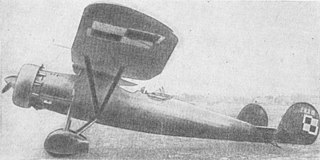
The RWD 5 was a Polish touring and sports plane of 1931, a two-seat high-wing monoplane, constructed by the RWD team. It was made famous by its transatlantic flight, being the smallest aircraft to cross the Atlantic.

The RWD 2 was a 1929 Polish single-engine high-wing monoplane sports plane constructed by the RWD team.

The RWD-10 was a Polish aerobatics sports plane, single-seat parasol wing monoplane, used from 1933 to 1939 and constructed by the RWD team.

The PWS-19 was a Polish reconnaissance and bomber plane prototype of the 1930s, constructed in the PWS.

Potez 25 was a French twin-seat, single-engine sesquiplane designed during the 1920s. A multi-purpose fighter-bomber, it was designed as a line aircraft and used in a variety of roles, including fighter and escort missions, tactical bombing and reconnaissance missions. In the late 1920s and early 1930s, Potez 25 was the standard multi-purpose aircraft of over 20 air forces, including French and Polish. It was also popular among private operators, notably mail transport companies.

The Caudron C.600 Aiglon is a 1930s French two-seat monoplane sport/touring aircraft built by Caudron–Renault.

The Potez 58 was a family of French light utility and touring aircraft, developed in mid-1930s. They were three-seat single-engine high-wing monoplanes.

The Farman F.430 was a 1930s French light transport designed and built by the Farman Aviation Works. Two variants with different engines were known as the F.431 and F.432.

The Farman F.190 was a utility aircraft built in France in the 1920s and 1930s. It was a high-wing, strut-braced monoplane of conventional configuration with a fully enclosed cabin and fixed, tailskid undercarriage. Popular both as a private aircraft and in the air taxi role, some 30 examples were also operated by airlines in France and elsewhere in Europe. Fifteen of these joined Air France's fleet in 1933 from the fleets of the smaller airlines it had absorbed.

The Levasseur PL.5 was a carrier-based fighter produced in France in the late 1920s, in response to the 1924 AMBC.2 specification issued by the Service Technique de l'Aéronautique (STAé). It was a conventional, single-bay sesquiplane that carried a crew of two in tandem, open cockpits. Like other Levasseur naval designs of the day, it incorporated several safety features in case of ditching at sea. Apart from small floats attached directly to the undersides of the lower wing, the main units of the fixed, tail-skid undercarriage could be jettisoned in flight, and the underside of the fuselage was given a boat-like shape and made watertight.

The Potez 36 was a French two-seat touring or sport monoplane designed and built by Potez.

The Potez X was a French 1920s general-purpose colonial transport aircraft designed and built by Potez.

The Morane-Saulnier MS.341 was a single engine parasol wing training and touring aircraft built in France in the mid-1930s. It had two open cockpits in tandem and was sold to private owners, clubs and the Armée de l'Air.

The Bernard 200 T was the first of a series of French light touring aircraft from the early 1930s. Single engined and seating three or four, they were high cantilever wing monoplanes. Four Bernard 200 T were built and subsequently modified into three further variants.

The Potez-CAMS 160 was a one-off 5/13 scale flight model built in France, first flown in the summer of 1938 to test aerodynamic and hydrodynamic qualities of the Potez-CAMS 161 airliner and mail carrier, which was too large for detailed modelling in existing wind tunnels.
The Morane-Saulnier MS-700 Pétrel was a French four-seat cabin-monoplane designed and built by Morane-Saulnier, only three prototypes were built.
The Bloch MB.60, initially known as the MB.VI, was a tri-motor mailplane designed and built in France from 1930 to 1931 to an order for an aircraft suitable for use as a postal, commercial or medical transport.

The Potez XIX was a prototype French night bomber built by Potez in the 1920s.
The Levasseur PL.400 was an artillery observation / liaison aircraft built by Société Pierre Levasseur Aéronautique in the late 1930s.
The Romano R.110 was a twin-engine 3-seat fighter aircraft, designed by Etienne Romano in the 1930s. A single prototype was built, but it was not successful, the Potez 630 being preferred.

















